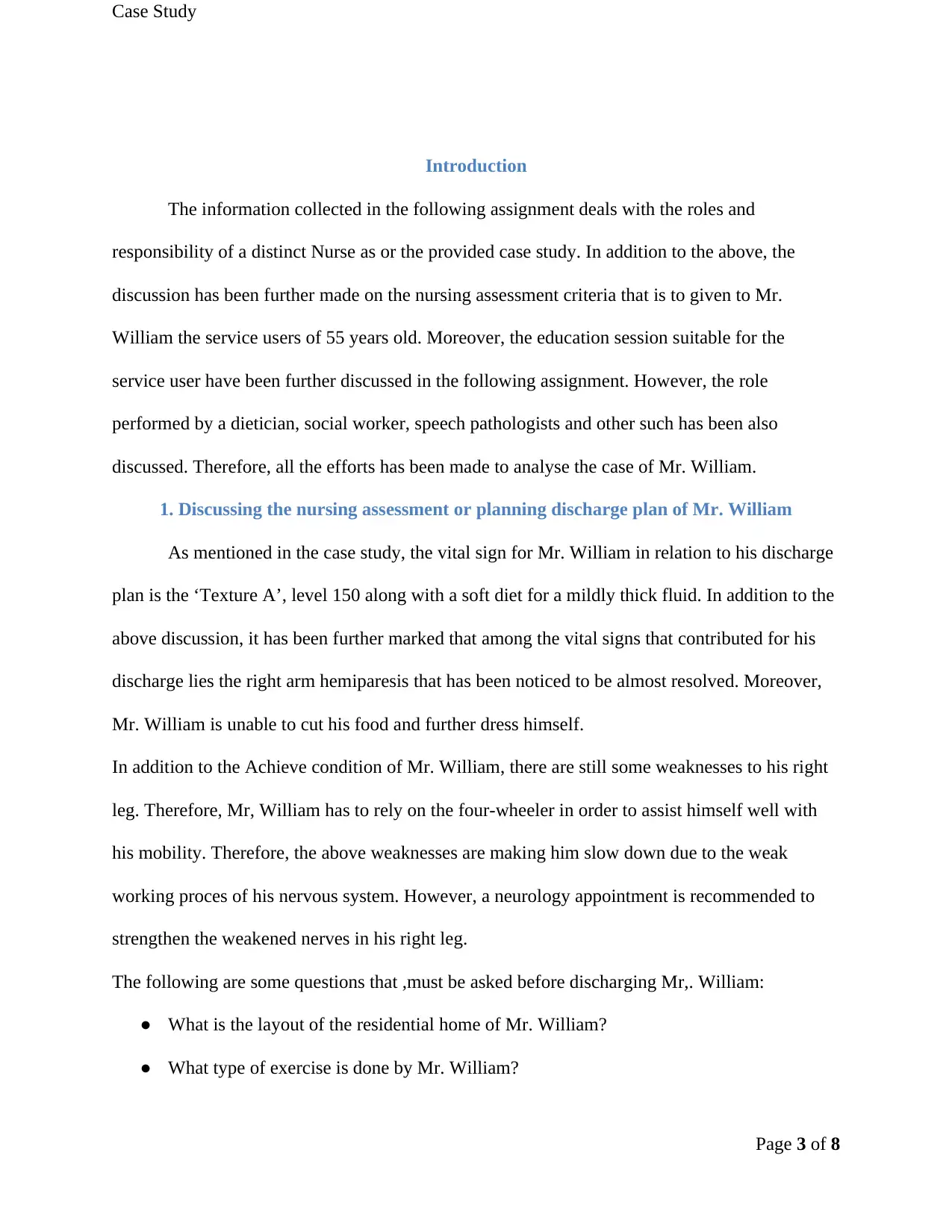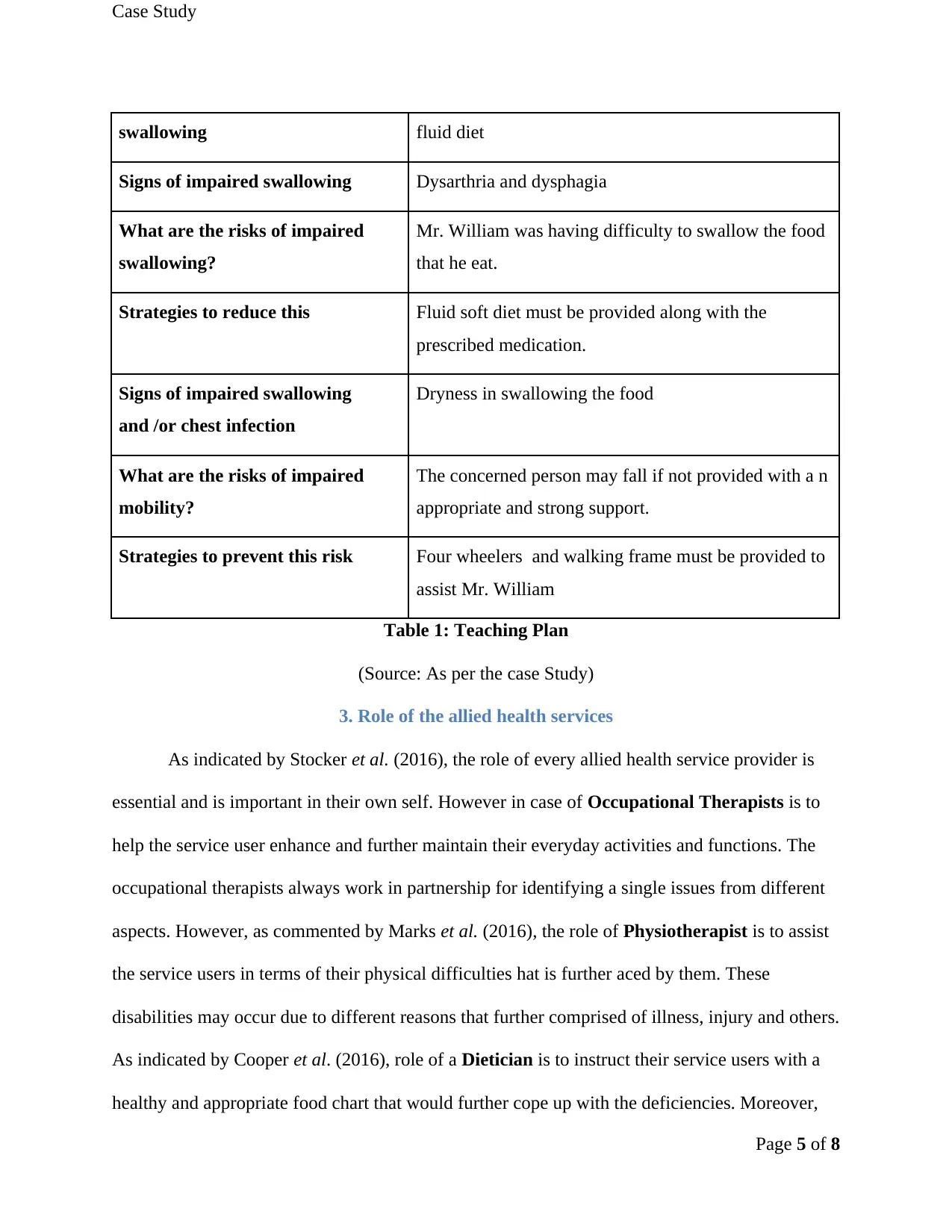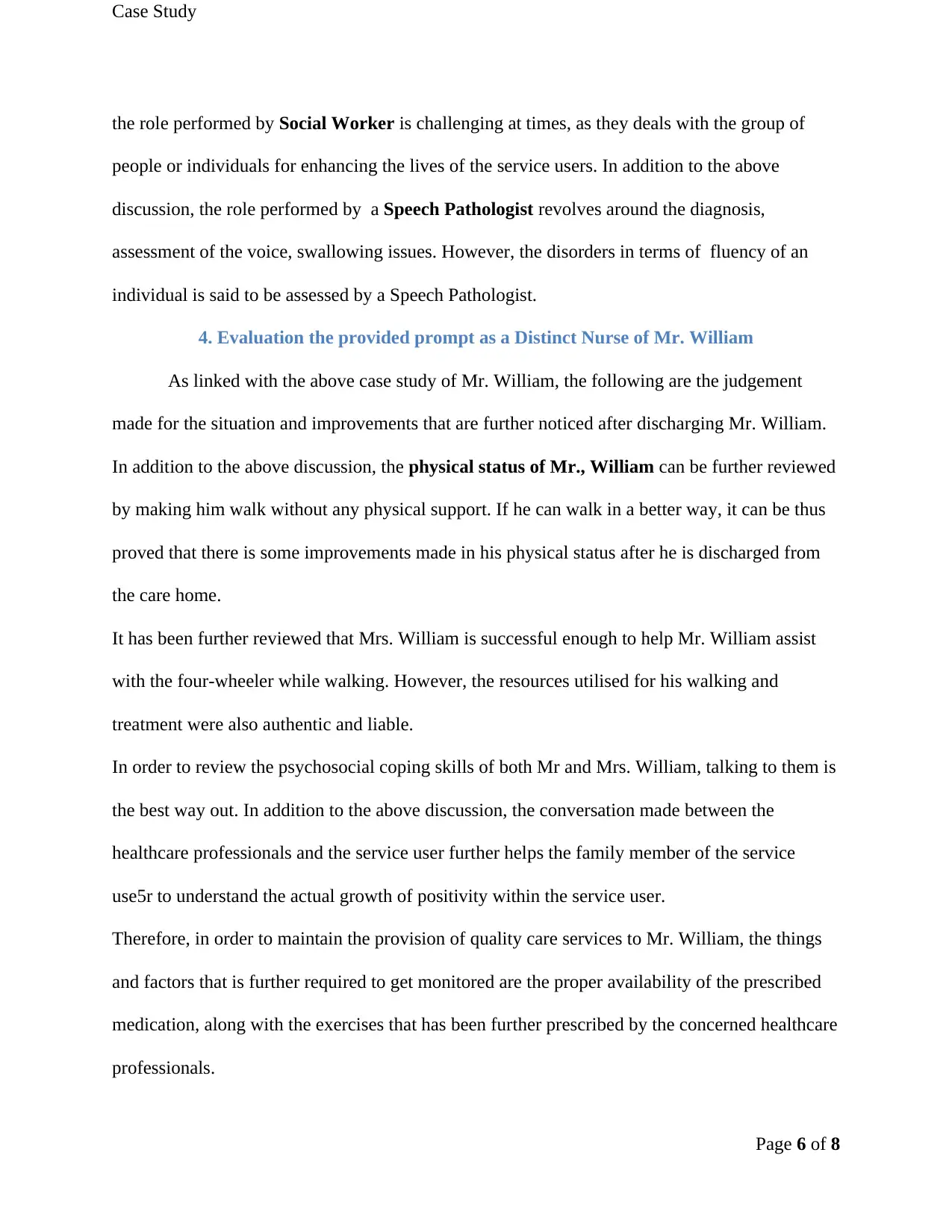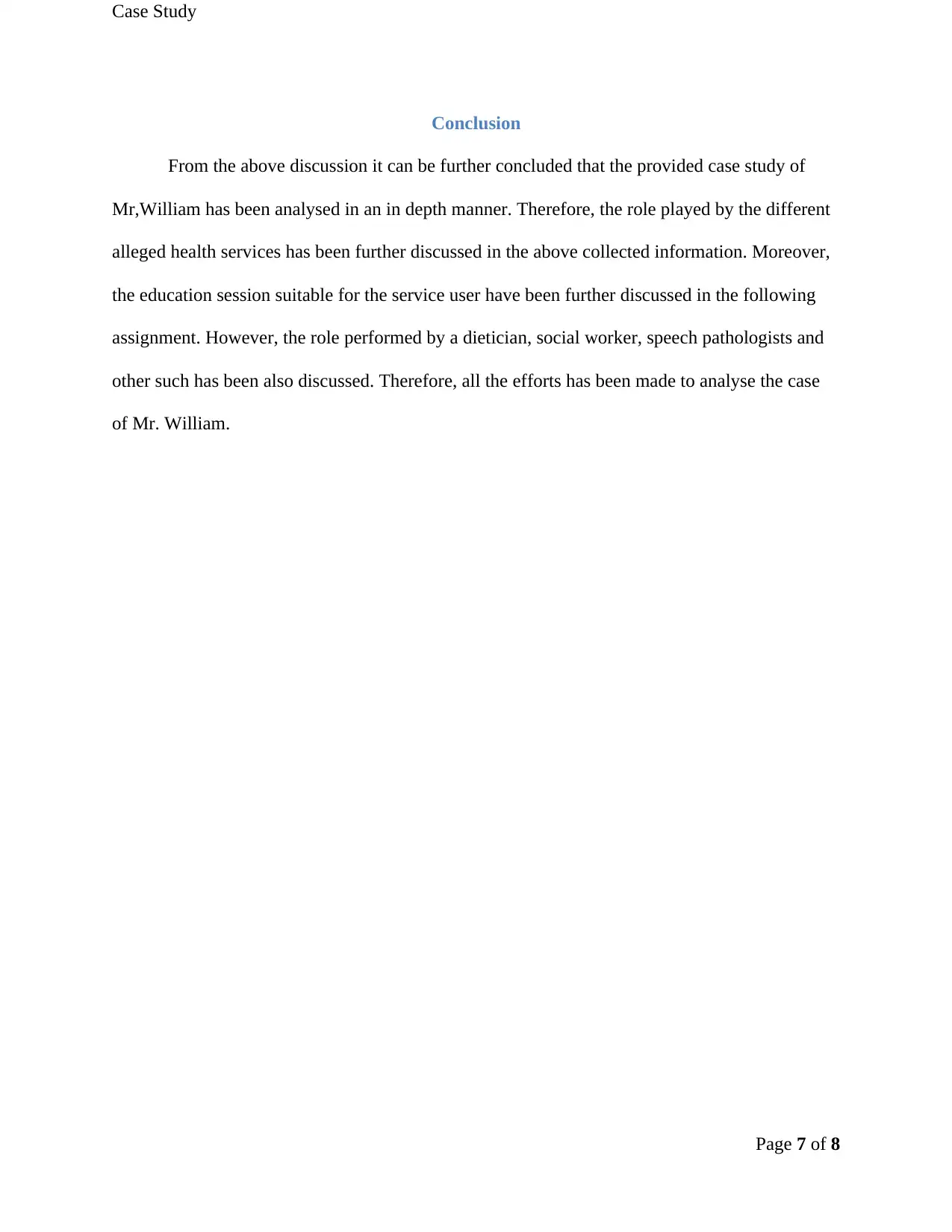Case Study Analysis: Nursing Care of Mr. William's Discharge
VerifiedAdded on 2020/01/23
|8
|1711
|581
Case Study
AI Summary
This case study analyzes the nursing care provided to Mr. William, a 55-year-old service user, focusing on his assessment, discharge plan, and the roles of allied health services. The assignment details the nursing assessment criteria, including vital signs, hemiparesis, and mobility limitations, and discusses essential questions to be asked before discharge. It explores patient education strategies, such as teaching plans related to swallowing and mobility, and highlights the roles of occupational therapists, physiotherapists, dieticians, social workers, and speech pathologists. The evaluation of Mr. William's care considers his physical status, psychosocial coping skills, and the importance of monitoring medication and exercises. The conclusion emphasizes the in-depth analysis of the case study and the significance of various allied health services in Mr. William's care and recovery.

Running Head: Case Study
CASE STUDY
Page 1 of 8
CASE STUDY
Page 1 of 8
Paraphrase This Document
Need a fresh take? Get an instant paraphrase of this document with our AI Paraphraser

Case Study
Table of Contents
Introduction......................................................................................................................................3
1. Discussing the nursing assessment or planning discharge plan of Mr. William.........................3
2. Education session of the patient..................................................................................................4
3. Role of the allied health services.................................................................................................5
4. Evaluation the provided prompt as a Distinct Nurse of Mr. William..........................................6
Conclusion.......................................................................................................................................7
References........................................................................................................................................8
Page 2 of 8
Table of Contents
Introduction......................................................................................................................................3
1. Discussing the nursing assessment or planning discharge plan of Mr. William.........................3
2. Education session of the patient..................................................................................................4
3. Role of the allied health services.................................................................................................5
4. Evaluation the provided prompt as a Distinct Nurse of Mr. William..........................................6
Conclusion.......................................................................................................................................7
References........................................................................................................................................8
Page 2 of 8

Case Study
Introduction
The information collected in the following assignment deals with the roles and
responsibility of a distinct Nurse as or the provided case study. In addition to the above, the
discussion has been further made on the nursing assessment criteria that is to given to Mr.
William the service users of 55 years old. Moreover, the education session suitable for the
service user have been further discussed in the following assignment. However, the role
performed by a dietician, social worker, speech pathologists and other such has been also
discussed. Therefore, all the efforts has been made to analyse the case of Mr. William.
1. Discussing the nursing assessment or planning discharge plan of Mr. William
As mentioned in the case study, the vital sign for Mr. William in relation to his discharge
plan is the ‘Texture A’, level 150 along with a soft diet for a mildly thick fluid. In addition to the
above discussion, it has been further marked that among the vital signs that contributed for his
discharge lies the right arm hemiparesis that has been noticed to be almost resolved. Moreover,
Mr. William is unable to cut his food and further dress himself.
In addition to the Achieve condition of Mr. William, there are still some weaknesses to his right
leg. Therefore, Mr, William has to rely on the four-wheeler in order to assist himself well with
his mobility. Therefore, the above weaknesses are making him slow down due to the weak
working proces of his nervous system. However, a neurology appointment is recommended to
strengthen the weakened nerves in his right leg.
The following are some questions that ,must be asked before discharging Mr,. William:
● What is the layout of the residential home of Mr. William?
● What type of exercise is done by Mr. William?
Page 3 of 8
Introduction
The information collected in the following assignment deals with the roles and
responsibility of a distinct Nurse as or the provided case study. In addition to the above, the
discussion has been further made on the nursing assessment criteria that is to given to Mr.
William the service users of 55 years old. Moreover, the education session suitable for the
service user have been further discussed in the following assignment. However, the role
performed by a dietician, social worker, speech pathologists and other such has been also
discussed. Therefore, all the efforts has been made to analyse the case of Mr. William.
1. Discussing the nursing assessment or planning discharge plan of Mr. William
As mentioned in the case study, the vital sign for Mr. William in relation to his discharge
plan is the ‘Texture A’, level 150 along with a soft diet for a mildly thick fluid. In addition to the
above discussion, it has been further marked that among the vital signs that contributed for his
discharge lies the right arm hemiparesis that has been noticed to be almost resolved. Moreover,
Mr. William is unable to cut his food and further dress himself.
In addition to the Achieve condition of Mr. William, there are still some weaknesses to his right
leg. Therefore, Mr, William has to rely on the four-wheeler in order to assist himself well with
his mobility. Therefore, the above weaknesses are making him slow down due to the weak
working proces of his nervous system. However, a neurology appointment is recommended to
strengthen the weakened nerves in his right leg.
The following are some questions that ,must be asked before discharging Mr,. William:
● What is the layout of the residential home of Mr. William?
● What type of exercise is done by Mr. William?
Page 3 of 8
⊘ This is a preview!⊘
Do you want full access?
Subscribe today to unlock all pages.

Trusted by 1+ million students worldwide

Case Study
● What are the issues faced by Mr. William?
● How much effective is the care taken by Mr. William?
● What are the medications taken by Mr. William?
● What are the changes observed by Mrs. William after providing treatment to Mr.
William?
The above question has been asked to identify the outlet of the home in which Mr. William lives.
Therefore, by knowing the layout, the healthcare professional would further structure certain
essential factors than must be remembered by Mrs. William while provide care to Mr. William.
2. Education session of the patient
As indicated by Blyth, Bost & Shiels (2016), the structure of teaching plan helps a
service provider to set the appropriate activities as per the case of the concerned service user.
Therefore, by linking the case study of Mr William, it has been further analysed that the care
treatment provided to the concerned service user helped him to overcome his pain, but is still in a
recovery situation before being discharged. In addition to the above discussion, after getting
discharged the service user is required to be cared in the same manner that was provided in the
cre homes. Therefore, by prescribing Mr. William with Perindopril 4 mg daily, Simvastatin 20
mg along with Clopidogrel 75 mg on daily basis, the risk of aspiration pneumonia can be
managed well. However, as commented by Mann (2016), a service user suffering with
Hypertension and Arteriosclerosis must be taken a special care. Therefore, by linking the case
study to the above discussion, Mr, William do not face any issues related to fall risk and
occupational therapists is send to the home of Mr. William for checking the environment of his
residence. The following is the teaching plan suitable for Mr. William:
Impact of disease process on Mr. William would be provided with the thickened
Page 4 of 8
● What are the issues faced by Mr. William?
● How much effective is the care taken by Mr. William?
● What are the medications taken by Mr. William?
● What are the changes observed by Mrs. William after providing treatment to Mr.
William?
The above question has been asked to identify the outlet of the home in which Mr. William lives.
Therefore, by knowing the layout, the healthcare professional would further structure certain
essential factors than must be remembered by Mrs. William while provide care to Mr. William.
2. Education session of the patient
As indicated by Blyth, Bost & Shiels (2016), the structure of teaching plan helps a
service provider to set the appropriate activities as per the case of the concerned service user.
Therefore, by linking the case study of Mr William, it has been further analysed that the care
treatment provided to the concerned service user helped him to overcome his pain, but is still in a
recovery situation before being discharged. In addition to the above discussion, after getting
discharged the service user is required to be cared in the same manner that was provided in the
cre homes. Therefore, by prescribing Mr. William with Perindopril 4 mg daily, Simvastatin 20
mg along with Clopidogrel 75 mg on daily basis, the risk of aspiration pneumonia can be
managed well. However, as commented by Mann (2016), a service user suffering with
Hypertension and Arteriosclerosis must be taken a special care. Therefore, by linking the case
study to the above discussion, Mr, William do not face any issues related to fall risk and
occupational therapists is send to the home of Mr. William for checking the environment of his
residence. The following is the teaching plan suitable for Mr. William:
Impact of disease process on Mr. William would be provided with the thickened
Page 4 of 8
Paraphrase This Document
Need a fresh take? Get an instant paraphrase of this document with our AI Paraphraser

Case Study
swallowing fluid diet
Signs of impaired swallowing Dysarthria and dysphagia
What are the risks of impaired
swallowing?
Mr. William was having difficulty to swallow the food
that he eat.
Strategies to reduce this Fluid soft diet must be provided along with the
prescribed medication.
Signs of impaired swallowing
and /or chest infection
Dryness in swallowing the food
What are the risks of impaired
mobility?
The concerned person may fall if not provided with a n
appropriate and strong support.
Strategies to prevent this risk Four wheelers and walking frame must be provided to
assist Mr. William
Table 1: Teaching Plan
(Source: As per the case Study)
3. Role of the allied health services
As indicated by Stocker et al. (2016), the role of every allied health service provider is
essential and is important in their own self. However in case of Occupational Therapists is to
help the service user enhance and further maintain their everyday activities and functions. The
occupational therapists always work in partnership for identifying a single issues from different
aspects. However, as commented by Marks et al. (2016), the role of Physiotherapist is to assist
the service users in terms of their physical difficulties hat is further aced by them. These
disabilities may occur due to different reasons that further comprised of illness, injury and others.
As indicated by Cooper et al. (2016), role of a Dietician is to instruct their service users with a
healthy and appropriate food chart that would further cope up with the deficiencies. Moreover,
Page 5 of 8
swallowing fluid diet
Signs of impaired swallowing Dysarthria and dysphagia
What are the risks of impaired
swallowing?
Mr. William was having difficulty to swallow the food
that he eat.
Strategies to reduce this Fluid soft diet must be provided along with the
prescribed medication.
Signs of impaired swallowing
and /or chest infection
Dryness in swallowing the food
What are the risks of impaired
mobility?
The concerned person may fall if not provided with a n
appropriate and strong support.
Strategies to prevent this risk Four wheelers and walking frame must be provided to
assist Mr. William
Table 1: Teaching Plan
(Source: As per the case Study)
3. Role of the allied health services
As indicated by Stocker et al. (2016), the role of every allied health service provider is
essential and is important in their own self. However in case of Occupational Therapists is to
help the service user enhance and further maintain their everyday activities and functions. The
occupational therapists always work in partnership for identifying a single issues from different
aspects. However, as commented by Marks et al. (2016), the role of Physiotherapist is to assist
the service users in terms of their physical difficulties hat is further aced by them. These
disabilities may occur due to different reasons that further comprised of illness, injury and others.
As indicated by Cooper et al. (2016), role of a Dietician is to instruct their service users with a
healthy and appropriate food chart that would further cope up with the deficiencies. Moreover,
Page 5 of 8

Case Study
the role performed by Social Worker is challenging at times, as they deals with the group of
people or individuals for enhancing the lives of the service users. In addition to the above
discussion, the role performed by a Speech Pathologist revolves around the diagnosis,
assessment of the voice, swallowing issues. However, the disorders in terms of fluency of an
individual is said to be assessed by a Speech Pathologist.
4. Evaluation the provided prompt as a Distinct Nurse of Mr. William
As linked with the above case study of Mr. William, the following are the judgement
made for the situation and improvements that are further noticed after discharging Mr. William.
In addition to the above discussion, the physical status of Mr., William can be further reviewed
by making him walk without any physical support. If he can walk in a better way, it can be thus
proved that there is some improvements made in his physical status after he is discharged from
the care home.
It has been further reviewed that Mrs. William is successful enough to help Mr. William assist
with the four-wheeler while walking. However, the resources utilised for his walking and
treatment were also authentic and liable.
In order to review the psychosocial coping skills of both Mr and Mrs. William, talking to them is
the best way out. In addition to the above discussion, the conversation made between the
healthcare professionals and the service user further helps the family member of the service
use5r to understand the actual growth of positivity within the service user.
Therefore, in order to maintain the provision of quality care services to Mr. William, the things
and factors that is further required to get monitored are the proper availability of the prescribed
medication, along with the exercises that has been further prescribed by the concerned healthcare
professionals.
Page 6 of 8
the role performed by Social Worker is challenging at times, as they deals with the group of
people or individuals for enhancing the lives of the service users. In addition to the above
discussion, the role performed by a Speech Pathologist revolves around the diagnosis,
assessment of the voice, swallowing issues. However, the disorders in terms of fluency of an
individual is said to be assessed by a Speech Pathologist.
4. Evaluation the provided prompt as a Distinct Nurse of Mr. William
As linked with the above case study of Mr. William, the following are the judgement
made for the situation and improvements that are further noticed after discharging Mr. William.
In addition to the above discussion, the physical status of Mr., William can be further reviewed
by making him walk without any physical support. If he can walk in a better way, it can be thus
proved that there is some improvements made in his physical status after he is discharged from
the care home.
It has been further reviewed that Mrs. William is successful enough to help Mr. William assist
with the four-wheeler while walking. However, the resources utilised for his walking and
treatment were also authentic and liable.
In order to review the psychosocial coping skills of both Mr and Mrs. William, talking to them is
the best way out. In addition to the above discussion, the conversation made between the
healthcare professionals and the service user further helps the family member of the service
use5r to understand the actual growth of positivity within the service user.
Therefore, in order to maintain the provision of quality care services to Mr. William, the things
and factors that is further required to get monitored are the proper availability of the prescribed
medication, along with the exercises that has been further prescribed by the concerned healthcare
professionals.
Page 6 of 8
⊘ This is a preview!⊘
Do you want full access?
Subscribe today to unlock all pages.

Trusted by 1+ million students worldwide

Case Study
Conclusion
From the above discussion it can be further concluded that the provided case study of
Mr,William has been analysed in an in depth manner. Therefore, the role played by the different
alleged health services has been further discussed in the above collected information. Moreover,
the education session suitable for the service user have been further discussed in the following
assignment. However, the role performed by a dietician, social worker, speech pathologists and
other such has been also discussed. Therefore, all the efforts has been made to analyse the case
of Mr. William.
Page 7 of 8
Conclusion
From the above discussion it can be further concluded that the provided case study of
Mr,William has been analysed in an in depth manner. Therefore, the role played by the different
alleged health services has been further discussed in the above collected information. Moreover,
the education session suitable for the service user have been further discussed in the following
assignment. However, the role performed by a dietician, social worker, speech pathologists and
other such has been also discussed. Therefore, all the efforts has been made to analyse the case
of Mr. William.
Page 7 of 8
Paraphrase This Document
Need a fresh take? Get an instant paraphrase of this document with our AI Paraphraser

Case Study
References
Blyth, C., Bost, N., & Shiels, S. (2016). Impact of an education session on clinical handover
between medical shifts in an emergency department: A pilot study. Emergency Medicine
Australasia.
Cooper, E., Brandrick, K., Mahmood, F., Macano, C., Sharples, A., Bedson, L., ... & Rao, V.
(2016). Impact of intensive dietician input on dietary patterns of patients undergoing bariatric
surgery. Surgery for Obesity and Related Diseases, 12(7), S169-S170.
Mann, K. (2016). Impact of an Interprofessional Education Session with Healthcare
Professionals on Attitudes Towards Interprofessional Teams (Doctoral dissertation, University of
Manitoba).
Marks, D., Comans, T., Thomas, M., Ng, S. K., O'Leary, S., Conaghan, P. G., ... & Bisset, L.
(2016). Agreement between a physiotherapist and orthopaedic surgeon regarding management of
shoulder pain and prescription of subacromial corticosteroid injection. Manual Therapy, 25, e42-
e43.
Stocker, J., van den Ende, C., Gevers, K., van Keeken, P., & Wilting, A. (2016). AB1112-HPR
Systemic Sclerosis Treatment: An Occupational Therapists' View. Annals of the Rheumatic
Diseases, 75(Suppl 2), 1312-1312.
Page 8 of 8
References
Blyth, C., Bost, N., & Shiels, S. (2016). Impact of an education session on clinical handover
between medical shifts in an emergency department: A pilot study. Emergency Medicine
Australasia.
Cooper, E., Brandrick, K., Mahmood, F., Macano, C., Sharples, A., Bedson, L., ... & Rao, V.
(2016). Impact of intensive dietician input on dietary patterns of patients undergoing bariatric
surgery. Surgery for Obesity and Related Diseases, 12(7), S169-S170.
Mann, K. (2016). Impact of an Interprofessional Education Session with Healthcare
Professionals on Attitudes Towards Interprofessional Teams (Doctoral dissertation, University of
Manitoba).
Marks, D., Comans, T., Thomas, M., Ng, S. K., O'Leary, S., Conaghan, P. G., ... & Bisset, L.
(2016). Agreement between a physiotherapist and orthopaedic surgeon regarding management of
shoulder pain and prescription of subacromial corticosteroid injection. Manual Therapy, 25, e42-
e43.
Stocker, J., van den Ende, C., Gevers, K., van Keeken, P., & Wilting, A. (2016). AB1112-HPR
Systemic Sclerosis Treatment: An Occupational Therapists' View. Annals of the Rheumatic
Diseases, 75(Suppl 2), 1312-1312.
Page 8 of 8
1 out of 8
Related Documents
Your All-in-One AI-Powered Toolkit for Academic Success.
+13062052269
info@desklib.com
Available 24*7 on WhatsApp / Email
![[object Object]](/_next/static/media/star-bottom.7253800d.svg)
Unlock your academic potential
Copyright © 2020–2025 A2Z Services. All Rights Reserved. Developed and managed by ZUCOL.





